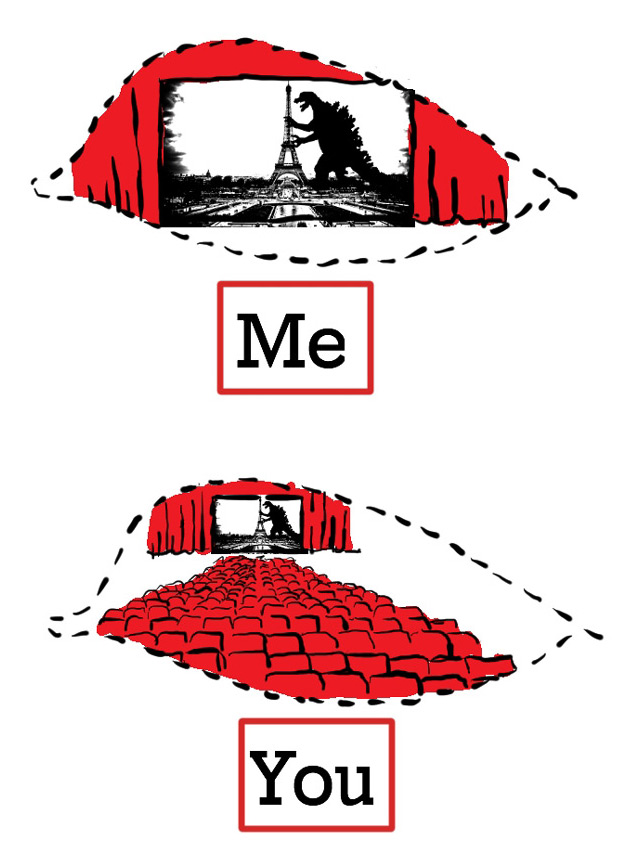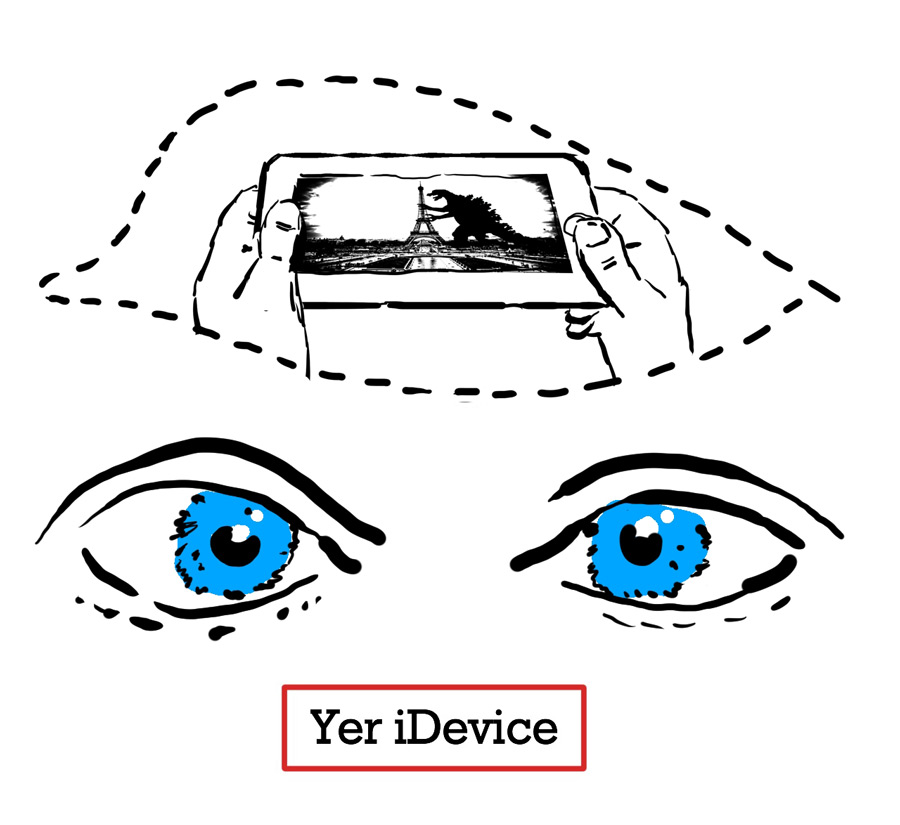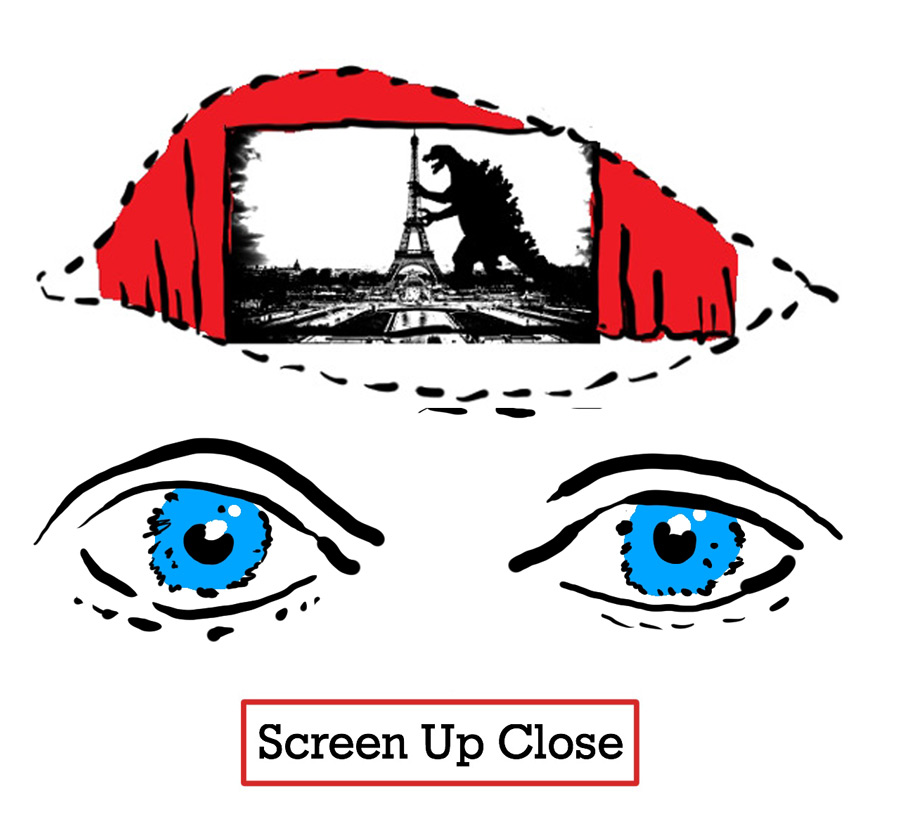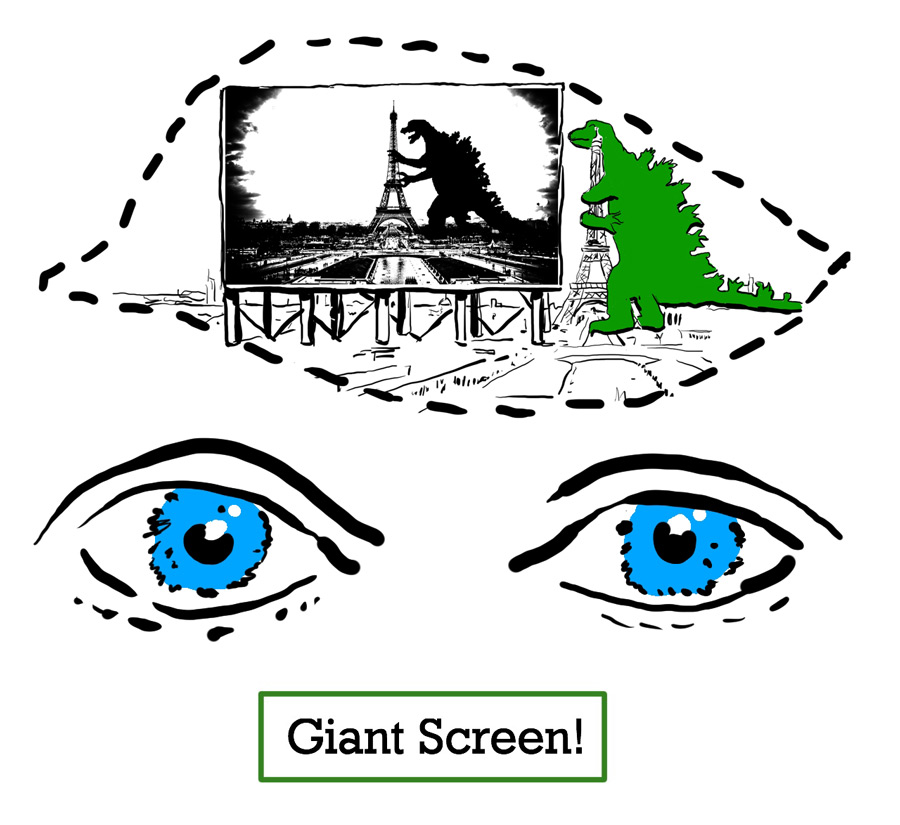
The third rule of two
Having said that there are only two rules of photography, let’s now add a third, and say that things that are farther away appear smaller, and possibly a fourth saying I can add, subtract and change rules at my whim.

That’s why they call them theories. Which they don’t, but I changed the rule again. But remember, long, long ago, when the otherwise talented and charming Mr. Aziz Ansari created a mini-kerfuffle about some theaters claiming to be IMAX when they are not. He was correct, of course, only by accident; these theaters because screen size doesn’t actually matter when it comes to whether or not something is or isn’t IMAX. Why? Well, it turns out that, when something large is far away, and something small is closer, they appear to be about the same size. It’s that rule you objected to. You don’t know this because in a movie theater you sit there, and I sit here:
But it’s more comfortable you say. I want it to look like my TV at home. But in so doing, Here’s how big the screen is for me,
Mommy, I made IMAX! I learned this trick a long time ago, that the closer you are, the more your eyes move, and the less likely you will be bored. Or rather, the less likely your confusion will let you know that you’re bored. Now, and in service of being a snob, one is forced to admit that there is some difference in perception when something is actually bigger, even if it takes up the same amount of room in our field of view. Most of us have stereoscopic vision which means if we’re viewing something on our phone, our eyes are closer together, telling our brain that the massive New Mexico vista is, in fact, four inches across.
When the screen is farther away, this seems less strange. Of course it doesn’t explain why Mr. Nicolas Cage’s face is 100 feet high.
What a historian would do is write a better article, and what they also might do is tell the story of IMAX in chronological order. For example IMAX was invented in a year that I can't bother to look up.
There’s also other things going on, like the amount of compression the lens in your iris is undergoing to focus on something, but iris compression is harder to show than it is to be clever using a metaphor as clunky as The Eyes of Dr. S.B. Eckelking. The point being, other than to worship Nicolas Cage as Your God, is that as you bump into things, your brain associates a certain amount of eye-crossingness and focus with a certain distance, making an IMAX screen slightly better for recreation of reality than a smaller screen (assuming no close ups, of course). That being said, a large screen is only a little bit better. As you can so obviously tell from the drawings, there is an actual difference in perception between seeing something on your phone and on a normal theater screen, and a tiny difference between a normal theater screen and a full size IMAX screen, set up for some reason on the Quay Branly. In each case, remember, that the size of the image, in terms of how much space it takes up in your visual field, is the same. No, what matters isn’t the size of the image, but the detail. If we follow size logic to its inevitable conclusion….
Pause.
Go ahead.
Get it out of your system.
….a giant blank IMAX screen is true IMAX, whereas a slightly smaller screen with eight gazillion pixels is not. No, what matters, in terms of tricking your brain into thinking what you’re watching is real, is detail. What a historian would do is write a better article, and what they also might do is tell the story of IMAX in chronological order. For example IMAX was invented in a year that I can’t bother to look up. At the time, there was no such thing as digital, so IMAX was designed to compete with film. So when you look up IMAX, you get this image,
but you really should get this one.
This is why it’s called 15 perf, by the way. They didn’t invent a new film stock, but instead used existing 70mm film and turned it on its side, creating fifteen perforations. This is finally where size matters, because the image is more detailed, as said in the first article, but in motivating myself to write this I didn’t realize it would get confusing to go back and forth. That’s the trade off: an unreadable article that’s finished, or a tolerable one that you will never read. Don’t say a word. It was rhetorical. The idea and the reality was that 15 perf IMAX has a lot more information, which makes it more like your eye is actually seeing it. Given that it was film, it was very expensive, so they would shoot stuff that was short and visually exciting, like space, and fish, and the pretty great even without IMAX Fires of Kuwait.
Then at some year something else happened. There’s probably an anecdote or something. Okay, fine, it was Disney and it was 2002, and they decided to release Beauty and the Beast and Aladdin in IMAX. That’s great, you say. Naturally they took the original cells and reshot them with a IMAX 15 perf camera.
Yeah, they didn’t do that.
Instead they did what you do all the time. They took a lower quality image and blew it up, in this case it wasn’t a photo to your grandma who doesn’t have the internets, but instead a tolerable image to IMAX size, which does not increase the quality. Hey, look, another rule, after I said there would only be twelve. I didn’t say that, but I did say I’d be making shit up. This one you may have heard before. As with audio recording and democracy, the weakest link determines the final result. It’s a simple case of Deep Star Six in, Leviathan out. Or Prefontaine in, Without Limits out. Um, Lovelace in, Inferno out?
As with Casablanca in, Barb Wire out (take that film reference geeks), when you take a low quality image and press the make big button, it still looks like the first one. I remember fondly when I was doing Scram which was 1) a ‘zine, and 2) the place I started writing crap like this. In any case, I was also in charge of the layout and was asked, many times, to take an out-of-focus photograph and ‘make it unblurry’. It’s photoshop. It can do anything.
Hey, it was the nineties. People thought like this. We were doing ‘zines fer chrissakes and saying ‘fer chrissakes’ fer chrissakes.
In a shocking revelation that could only come from a press office, CSI is not real life. You cannot make a silk Adams from a sow’s Mahurin (I told you: the nineties). You could object and say that the IMAX upconversion process can add detail. This is not true. It can extrapolate detail, which is great if you’re trying to read the license plate of some guy comparing terrorism to JJ Abrams style narrative (which strangely I hadn’t done until now), but it’s not great if you want the simple pleasure of a pretty image. It’s the British equivalent of food, which is, you can tell what’s going on, but there’s no joy in the aesthetics in it.
Now that should get someone on my license plate.
Here’s what an upconvert does. You take this:
And get this.
Yeah, much better. Honestly, don’t we prefer the 8 bit super mario dachshund? She could totally jump over a fireball and into a pipe. Especially if there was an 8 bit badger in there. And yes I made that joke in the last article, but it was about dachshunds this time.
So…
If you film something on your phone, then ‘upconvert’ it to IMAX it’s not going to look like To the Wonder. Likewise, if you film something in IMAX, downconvert it, and then show it in an IMAX theater, it’s going to look like the smallest version. But then things got even worse.
You see around this time was the popularization of the digicam, thanks largely to that idiot Mr. George Lucas. This is going to get very confusing now, because there are two parts to this story, the projection and the camera, which is weirdly the same size as a 35mm camera. Three parts. So it’s going to require a lot of concentration on your part. You ready?
Good, because I’m taking a break.
When I’ve finished the new bit, it will say ‘Break’s over’. Until then it will say that’s going to say that.
Break’s Over. Or rather, break was over 7 months ago, but as usual it was the link to the break that took all the time. Don’t they have nanobots to take care of this stuff?
Thoughts on Mommy, what's IMAX?, pt. 2

 [logo]
[logo]








Brain. Hurts.
Then I have succeeded. That is the purpose of education, right?